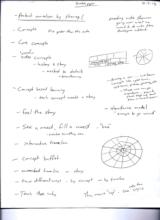|
Basic Assignments
|
Options & Settings
|
Main Time Information
|
||||||||||||||||||||||
|
|
|
|
|
|||
|
|||
|
|
|
Notes:
|
|
Meeting with my sister going over what we want to do with the developer’s notebook: (Other sketches & diagrams can be found on the scan in the photo gallery) - Protect ourselves by sharing! - Concepts – 10x greater than the code - Core concepts - “Visual” or video concepts o History & story o Nested to details o Brainstorming - Driving a car... we learn concepts like right turns, left turns, parking, passing, etc. Then we can go anywhere… even to places that we don’t know or haven’t been. - Concept based learning o Each concept needs a story - Feel the story - Abundance model – “enough to go around” - “See a need, fill a need.” – Robots movie. o Creates something new - “Base” - Interactive timeline - Concept buffet - Animated timeline or story – The movie “Up” – see entry from 1/5/13 - Two different ways – by concept or by timeline - Teach the why - When recording data (actual pieces_ we will need two pieces… what concept or subject and what timeframe - Figure out the core concepts – 20(ish) – (subs or subs of nesting) - Let’s do 10 – everything is somewhat built on this kind of model – (plate & cups sketch: with the main (plate) and cups (line items, payments, system history, flex grid, other content, custom docs, photos, etc.) o Centralizing data o Going to the source o Empowering the user o Permissions and settings o Objects and data over time o One-to-many relationships o See a need, fill a need – “base” foundation o Next logical step – development o Systems thinking o Games o Data o Adilas – all dad is live and searchable o Dynamics o Relationships o Education and sharing o Types and function (why) o Roll call o Scalability o Custom o Dreaming o What is your story – “record the story” o Communication o Players o Culture, vocabulary & change o Put things to rest “life cycle” o Mix & blend o Catch the pieces o Data mapping o Peace of mind o Paint the picture – vision of the future o Open entry, open exit (no contracts, pick & choose, only use certain pieces, etc. - This is how we track and manage data…. We Mix Concepts & Players - We are almost coming full circle instead of us dictating flow, processes, and interface – we want people to mix and blend concepts and players to make their own flow, processes, and interface |


